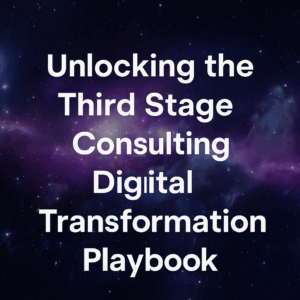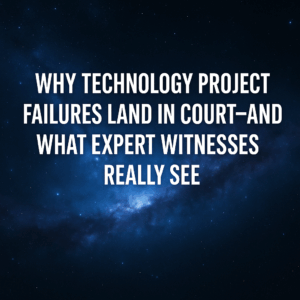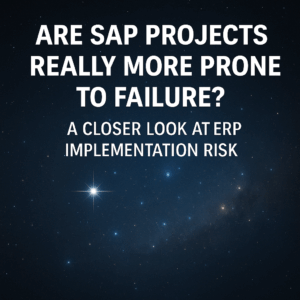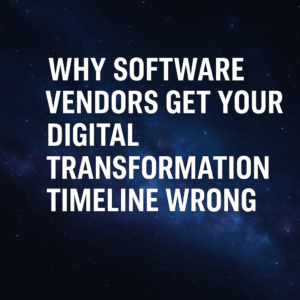When it comes to business transformation one of the main points to consider is who and what the main areas/elements need to be considered before any business change needs to be addressed.
Usually, a project will be initiated to solve a problem or to introduce a new function within the business; the usual approach is to understand and capture the business and systems requirements and align them to the business objectives outlined in the business case… Easy right? Well, that depends…
Joe has a big budget, so he decides to buy the Ferrari everyone’s been raving about. Not only does it meet his requirements, but it will also get him to point B faster. Plus, it has all the bells and whistles, and, let’s be honest, it makes him look cool. Bob at the dealership even told him the car screams, “I mean business.”
However, Joe didn’t think everything through. He didn’t consider how his wife and kids would fit into the picture. He overlooked whether his local mechanic, who services his other cars, has the tools and expertise to work on a Ferrari. Most importantly, Joe forgot to think about how he’ll actually use the car. Where will he put the weekly groceries, the kids’ bikes, or even his family?
Taking this example in the world of IT Business Transformation – the main elements (and not limited to) we should consider regarding business change is the following:
- PEOPLE: are Joe’s wife and kids.
- TECHNOLOGY: Joe’s Ferrari and his local mechanic
- PROCESS: Joe’s activities – weekly shop, carrying the kid’s bike’s and family
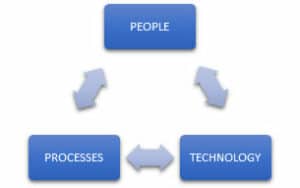
Table of Contents
TogglePEOPLE
During business change, it is imperative that key stakeholders are consulted and informed where the change will directly impact them. It is key that we understand what the roles of the people are, where they fit into the organization, and their understanding of how the change will affect them – including training needs analysis and acceptance, with the overarching of communication throughout.
Many organizations will assume that new systems will be adopted by the staff, they will embrace change without any ‘handholding’ – without any form of communication or visibility of the project. For Joe he obviously thought his wife and children will be fine with the car, moving from a MPV to a Ferrari is easy right? ‘I know my family they’ll understand’ he says. Clearly, so organizational change management is needed.
PROCESSES
The key to any organizational operation is to understand and have documented processes of how the organization works like a well-oiled machine. Without clear processes in place, the organization could be operating inefficiently, without visibility, and/or without set procedures and controls. The most common issue that arises when going through IT change is that during the AS-IS exercise – stakeholders often vary in the way they do things; even though they are carrying out the same process.
This is either they don’t know how to use technology, lack of training, or even the common response ‘but this is how we have always done it’. Once we establish the reasons and the ‘correct ways’ of working – we can define the TO-BE processes and make sure they reflected the People aspect of who should is responsible for carrying out tasks; and define what elements of Technology should contribute to the process. This is why during business change – processes need to be defined, agreed upon, and then re-engineered to make sure they bring value to the organization.
So, what’s Joe’s processes with this Ferrari? Well, what Joe failed to realize was that his weekly shop will not fit in the car because there is no boot, and the car has only 2 seats… In other words, Technology does not fit the process in this case. Joe didn’t look at how he operates or consulted his stakeholders on current ways of working before making his decision on the car – he has a dilemma. ‘That’s ok, I’ll stick the shopping on the seat and do 2 runs to the supermarket’ he says.
TECHNOLOGY
Technology selection is crucial to a project’s success – to make sure that the systems that are being implemented are fit for purpose and can be maintained, including being cost-efficient.
By just taking the requirement from the outset and then looking at the market leader or what others are using may not always be the choice and will indeed have a catastrophic impact on how the organization operates.
Doing an in-depth analysis into how the organizations operate (apart from the initial requirements gathering and engineering), we need to make sure the Technology meets the business objectives – including satisfying what current pain points are, what improvements are needed, and any opportunities that can be discovered for the wider organization.
In addition, we must understand if the Technology will fit in with the current infrastructure that is in place with the organization – including management and integration. If this doesn’t fit; support would need to be outsourced or for additional resources/Technology to be bought in – which would be an additional cost.
For Joe, the Ferrari meets the requirement, and Bob at the dealership has shown him the best there is and what everyone’s raving about – but is the car fit for purpose for his family? If his mechanic cannot maintain it – will it need to go to Ferrari Dealership with premium prices? ‘But everyone is using it!’ says Joe… but are they?

Hold on… there’s one more thing.
More than ever organizations are looking at data and how it plays a major part in operations. Organizations need to make sure that the data they are using is up to date, accurate, and sufficient. That is why within this framework – data is key when addressing:

- People: Understanding their roles and responsibilities, influence, and contribution to business change.
- Processes: Understanding the data that is required to be used to complete an end-to-end process, including how it needs to be manipulated and executed.
- Technology: Understand how the Technology will use the data that the organization will use to carrying out business processes.
Final thoughts…
Ultimately the key point to take away from carrying out business change is that any change that is bought to an organization must bring value and efficiency to how it operates in the future. Having a clear strategy that involves clear and concise involvement of key stakeholders, executive alignment, understanding and defining new ways of working, and finally selecting the right Technology to complement these two elements – will deliver a successful outcome.
One key point to take away is that the Business Objectives must drive the Technology – not the other way round. Technology-driven projects will ultimately require processes to change in order for it to work, and people to be adapt to new ways of working which will require an upskilling, different mindset,s and inefficient ways of working. Just like Joe – he will have to change his processes, change his wife’s mindset to drive a car that is impractical, and manage a car that will ultimately cost him a fortune to run and his family will not be happy with…
Have questions about business transformation? Or just want to chat about Ferraris? Please feel free to reach out to us: info@thirdstage-consulting.com.


